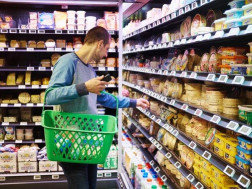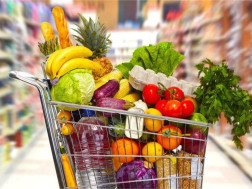In January 2021, consumer inflation accelerated in annual terms to 6.1%, up from 5% in December. In monthly terms, prices grew by 1.3%. This is according to data published by the State Statistics Service of Ukraine (SSSU).
According to the National Bank of Ukraine, actual consumer inflation, as expected, breached the upper bound of the 5% ± 1 pp target range. At the same time, it was slightly lower than projected trajectory published in the January 2021 Inflation Report. Rising prices for certain foods, fuels, and tobacco products, along with further growth in consumer demand, generated pro-inflationary pressures. However, inflation was restrained by lower prices for natural gas. As anticipated, the January lockdown had little effect on price dynamics.
Core inflation accelerated (to 5% yoy, up from 4.5% yoy in December 2020).
Prices for processed foods rose more quickly (by 5.8% yoy). As in previous months, sunflower oil prices rose sharply due to lower sunflower yields and higher global prices for edible oils. This affected prices for mayonnaise and spreads that are made with sunflower oil. Higher prices for inputs and energy spurred the growth in prices for flour and pasta. Rising input prices also affected the prices of meat products. The weakening of the hryvnia in previous months and stronger consumer demand accelerated the rise in prices for cheese, rice, and fish products.
Prices for nonfood products also grew at a higher rate (2.6% yoy). This also was because consumer demand strengthened and prices reflected the previous months’ depreciation of the hryvnia. Specifically, the growth in the prices for household appliances, pharmaceuticals, and cars continued to accelerate in January, while the decline in prices for electronic devices slowed somewhat. As expected, prices for clothing and footwear also fell more slowly. This may have been due to a smaller impact of winter sales on prices in January, as the sales started already in December in anticipation of the January lockdown.
The growth in services prices remained practically unchanged, at 6.8% yoy. On the one hand, prices increases for travel services, housing rentals, and car maintenance accelerated amid rising consumer demand and production costs. On the other hand, the growth in prices for healthcare and dental services, cinema tickets, sports facilities services, restaurant meals, hotel accommodations, and dry cleaner services decelerated as the attendance of these institutions decreased due to the lockdown.
The growth in raw food prices sped up (to 5.5% yoy).
In particular, the slump in production, coupled with higher production costs, led to a significant rise in prices for eggs and slowed the decline in the prices of chicken meat. Sugar and flour became more expensive due to high global prices and poorer harvests of sugar beet and wheat. The rise in fruit prices accelerated somewhat, driven primarily by higher prices for oranges, apples, and kiwis.
With vegetable stocks shrinking, prices for vegetables used in cooking borshch fell more slowly, but remained lower than last year. Meanwhile, cucumbers and tomatoes continued to fall in price as Turkey ramped up shipments of these vegetables at prices below last year’s levels.
With vegetable stocks shrinking, prices for vegetables used in cooking borshch fell more slowly, but remained lower than last year. Meanwhile, cucumbers and tomatoes continued to fall in price as Turkey ramped up shipments of these vegetables at prices below last year’s levels.
The increase in administered prices accelerated (to 11.7% yoy). A planned hike in excise taxes made tobacco products more expensive. Prices for alcoholic drinks returned to growth, in part due to higher price floors for sparkling wines. As expected, electricity became more expensive after the preferential electricity price for households was abolished.
Ukrtelecom also increased its rates for local and long-distance communication services. The growth in natural gas prices in previous periods affected the prices of hot water supplies and heating. At the same time, natural gas prices grew somewhat more slowly as natural gas suppliers lowered their January prices.
Ukrtelecom also increased its rates for local and long-distance communication services. The growth in natural gas prices in previous periods affected the prices of hot water supplies and heating. At the same time, natural gas prices grew somewhat more slowly as natural gas suppliers lowered their January prices.
The fall in fuel prices decelerated (to 4.7% yoy) due to rising global oil prices and sustained strong demand from households.
Consumer inflation in January accelerated and breached the upper bound of the 5% ± 1 pp target range. Given last year’s low crop yields, rising energy prices, and further growth in consumer demand, consumer prices are expected to continue to grow in H1 2021.
“Going forward, the impact of pro-inflationary factors will ease, and the inflation pattern will reverse,” reads the report of NBU, adding that food price inflation will decelerate thanks to an increase in supply of newly-harvested agricultural products, and the effect of low comparison base will vanish for some goods at the end of the year.
















